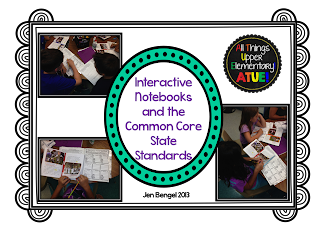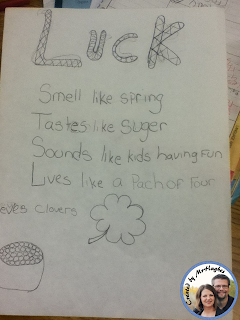Hey there!! This is Amanda from Collaboration Cuties and I am so excited to be guest blogging here today!!
Today, I wanted to share with you how we use mentor texts in our classroom! If you follow our blog at all, you know that we loooooove mentor texts! We have a linky each week devoted to it! If you haven't stopped by to see all of the amazing texts linked up, start HERE (after reading this post!) to check out what we've been up to!! Be warned!!! I had to switch to an Amazon Prime account after we started this linky because there were so many great texts linked up that I HAD TO HAVE RIGHT THEN! ;O)
Okay, so on with using mentor texts...I know that a lot of upper elementary teachers are departmentalized, so it may be that this particular book isn't something you might use, but you will get the general feel for how you could use any mentor text, no matter the subject area you teach in!
The book I want to tell you about is called Roanoke, The Lost Colony by Jane Yolen. Jane Yolen is definitely one of my favorite authors because she is amazing at writing historical fiction!
Today, I wanted to share with you how we use mentor texts in our classroom! If you follow our blog at all, you know that we loooooove mentor texts! We have a linky each week devoted to it! If you haven't stopped by to see all of the amazing texts linked up, start HERE (after reading this post!) to check out what we've been up to!! Be warned!!! I had to switch to an Amazon Prime account after we started this linky because there were so many great texts linked up that I HAD TO HAVE RIGHT THEN! ;O)
Okay, so on with using mentor texts...I know that a lot of upper elementary teachers are departmentalized, so it may be that this particular book isn't something you might use, but you will get the general feel for how you could use any mentor text, no matter the subject area you teach in!
The book I want to tell you about is called Roanoke, The Lost Colony by Jane Yolen. Jane Yolen is definitely one of my favorite authors because she is amazing at writing historical fiction!
We are just getting started with our unit in Social Studies on the Thirteen Colonies, and I am launching it with this book. Here is the description from Amazon:
In 1587 John White was chosen by Sir Walter Raleigh to lead a new colony at Roanoke off the Atlantic coast. After bringing many men, women, and children to the new land, White went back to England to gather supplies for the long winter. But when he finally returned to the fort almost three years later, he found that all of the colonists had vanished. The only signs of life left were the letters CRO carved into a tree and the word CROATOAN carved into one of the fort's posts. Some people think that the Spanish army captured the colonists; some people think that the local native people murdered them; others think that the colonists went off to live with the native people and start a new life. Still others think that the colonists tried to sail home to England and were lost at sea. No one knows for sure.
When I use the term mentor text, I am talking about a text that will be used for more than one reading or lesson. Usually, if I truly wanted to use a book as a mentor text, I try to use it over a week long period.
In planning to use this book, here are the lessons I would use with it. Since each of us has different amounts of time for our language arts block or social studies block (or whichever subject you teach), I will just number the lessons since we would all have to do it at our own pace that works within our classroom. :O)
Lesson 1
First off, I would read the book in social studies. I am using this as a launch for the unit, so I want to make that social studies connection. I would not read the vocabulary yet...that comes in lesson 2.
While reading the book, I would have my students fill out a FQR chart. I could type out one for them, but since we use interactive notebooks, I would have them complete this in their journals.
The purpose of a FQR chart is to engage students with the text and get them thinking and questioning what they are reading (or hearing read). They write down facts in the left column, questions they have about the fact in the middle, and if they find a response in the text, they can fill in the response column, or, they may have to make an inference. Here is an example we might write while we are reading the text.
Now, this text has some great features to it.
 |
| From Roanoke, The Lost Colony |
Each set of pages has a "sticky note" with vocabulary words on it from the passage. It also has facts on the spiral bound page (like the one on the left) that gives even more information.
So...
Lesson 2
Vocabulary- There is a lot of great vocabulary highlighted in this book (and she put it on sticky notes, which I love about her!). So, I would read the book again, but focus on the vocabulary words. We would complete a vocabulary chart in our reading notebooks using these words.
We've used a chart as simple as this (yes, I know it's not very cute...) ;O)
Or, one like this, which you can get in our TpT store for free by clicking on the picture.
Depending on which organizer I used, I may have them inference what the word means, or I may just read the sentence it is in and have them use context clues BEFORE reading the definition on the sticky notes to check their thinking. I would also take the time to point out how Jane Yolen inserted the definitions cleverly throughout instead of at the end in a glossary.
Lesson 3
We are working on informational writing right now and I would ask students to go back into their rough draft, and decide how they want to highlight key vocabulary. Some may have already highlighted them, while others may be making a glossary. Now, they have another option to try in their own writing!
Lesson 4
Close reading- Here, we would do a close reading of this page in the text. This is the first page. I would photocopy this (since one page is allowed to be copied from the book) and we would paste it into our journals.
First off, there is quite a bit of vocabulary here that is not defined in the book. We would discuss this. Then, we would discuss cause and effect, highlighting causes in one color and the effects in a different color.
Some of the sentences state events that could be a cause and an effect. We would write those in our journals as both, showing their relationships. For example, the passage says that the native people were infected with European diseases. Well, the colonists coming to their land caused this. But, since they were infected with the diseases, the effect (that isn't stated) is that many of the native people died. We would add this in our reading journals.
There are several pages in this text that could be used for this skill. A few pages after this first page, there is another passage with less information. This would be a great passage to use to differentiate in small groups with a lower reading group.
Lesson 5
Writing- I would have them write in their writing journals about what they think happened at Roanoke and to use evidence from the text, and what we had been learning, to support their thinking. At the end of the book, there are theories that Jane Yolen shares about what may have happened. Also, with writing, I would have them write about whether they think John White made a good decision to bring colonists with them and then to leave them, using evidence to back up their thinking.
There is also a timeline, so this is a great text feature to share with students. They can easily make a timeline as we start our colonies unit and continually add to it as we go along in social studies!
Other Activities:
We use mentor sentences in our classroom to teach grammar within writing. If I were to choose a sentence from this book (which was really hard!) I'd choose this sentence:
On August 18, White's daughter Eleanor gave birth to Virginia Dare, the first English child born in America.
I would choose this sentence to work on the following grammar skills: capitalization, dates, possessive noun, commas.
(For more about how we use mentor sentences, you can go to our post HERE.)
Fact and opinion- Students could discuss facts and opinions with this text (what did Jane Yolen include that were facts and what may have been her opinions) or have them create their own fact and opinion game using facts from the story. On cards, they could write facts and then their own opinions and have classmates play the game, sorting by facts and opinions.
There are really so many things that you can do with just one book...I could go on and on...but I won't because I don't want to overwhelm you!! :O) This is just a topic that I LOVE!!
Hopefully you found something in this post that you could use! If you have any questions, please let us know! Thank you so much to All Things Upper Elementary for hosting us!
Stop by and see us sometime!!
Amanda
Find us at our BLOG
Find us on FACEBOOK
Find us on INSTAGRAM
















.jpg)
.jpg)
.jpg)


































